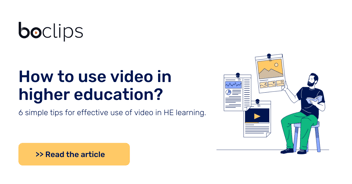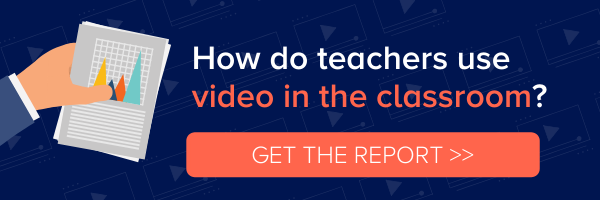In the not-so-distant past, higher education lectures were almost entirely instructor-led with a heavy focus on written learning materials. Students would spend hours of their week trying to absorb long and complex texts, regardless of their preferred learning style. Then, they would sit in a lecture hall and listen to a professor talk while they listened, often with little audience interaction. For some, this was an effective and enjoyable way to learn but, for many others, it wasn’t quite so engaging.
Lectures are Evolving
Now, higher education institutions are adapting teaching methods to meet the needs of a wider range of learners and learning styles. Millennials and Generation X have grown up with a constant stream of interactive media. They consume current affairs via short news clips; chat with their friends on Facetime, and study for high-school exams with YouTube favorites like Crash Course. Young people are used to innovation in every other part of their lives, so why should they go back-to-the-past for their post-secondary studies?
The good news is that institutions around the world are tuning in to the need for contemporary and engaging methods of teaching and learning. One of the easiest and most effective ways to modernize the higher education curriculum is to incorporate video into the course material. Not only does this improve student satisfaction with learning (source), but it also allows universities to offer online or distance learning and to support students who require a more flexible approach to their studies.
A 2017 study from ProQuest shows that the use of video in higher education had doubled between 2014 and 2017 (source). But how are today’s post-secondary institutions using video? Read on to discover the top 6 ways, which can be used individually or combined to suit the needs of lecturers and students.

1- Pre-lecture Material
Flipping the classroom is a popular method in schools and it’s just as effective in higher education. Before the lecture, students watch videos explaining the topics and concepts that will be covered in the upcoming class. Then, in the lecture, the instructor can begin with a quiz or discussion to gauge understanding before tackling common misconceptions and questions. The time saved going over the basics of the course material means that students can focus on deepening their understanding during the lecture.
2- Lecture Replacement
For institutions that offer online or hybrid classes, the in-person lecture can be replaced entirely by a recording. An instructor might film some sections themselves and supplement these with additional videos to provide a broader perspective. Opportunities for discussion can then take place online or in-person, depending on the setup of the university and the students’ needs. Even for courses that take place in person, video lectures can be an important addition for students who need to fit their learning around childcare, other work, or medical requirements.
3- Supplemental Material
By using supplemental material during a lecture, the instructor can bring in outside expertise and examine the topic in context. Archive footage of the Spanish Civil War during a history lecture or interviews with Chomsky shown in a linguistics seminar allow students to draw connections between the learning material and its application in the real world. Not only does this help to reinforce the material, but it also engages students in their learning. It’s easy to disconnect from something that’s only covered in theoretical terms, but real examples emphasize the importance of the topic in the wider world.
4- Homework and Assignments
After the lecture has taken place, the instructor can assign videos that summarize the topic or provide additional examples and viewpoints. Bigger-picture material, such as TED Talks, is really useful here to tie everything together. Students can watch the videos in their own time and then answer questions or complete an assignment based on what they’ve learned.
5- Interactive Videos and Simulations
For practical subjects, specialist videos such as surgery simulators or interactive science models can be useful to provide experience of “hands-on” work. It’s not always possible for students to visit a hospital or a lab, especially in distance learning situations, making this so this type of material an important substitute. While the adoption of this kind of media is limited at the moment, it’s likely that we’ll see the use of these tools increase in the future.
6- Virtual and Augmented Reality
Similar to the interactive videos above, virtual reality allows learners to visit places that they may not have the opportunity to go otherwise. History students can see the Athenian Acropolis up close, while those studying art can wander through the galleries of the Louvre. Allowing students to experience these places for themselves in 360 can be motivating and lead to discoveries and discussions that wouldn’t be possible otherwise.
Of course, nothing can replace inspiring lecturers who can share their knowledge and research with students, and key texts will always play an important role in higher education. But, by providing students with different ways to access the learning material, universities can increase accessibility, student engagement, and learning attainment (source). Today’s students have grown up with immediately available and interactive information at their fingertips. Now, they expect to be able to learn at their own pace and to be able to fully engage in the material provided to them (source). Video is a great way to meet them where they are.
Suzanna Taylor
Suzanna is a marketing specialist at Boclips. As a former languages teacher, she is passionate about quality, accessible educational resources.
- #Classroom
- #Video in Digital Learning
- #Educational Videos
- #Tips for Using Video
- #Video Content Partners
- #Boclips for Publishers
- #Issues in Education
- #Educational Videos by Subject Area
- #News and Announcements
- #Events & Holidays
- #Video and Teaching Tools
- #Teaching Methodologies
- #Education Videos
- #Video and Digital Literacy
- #Short Educational Videos
- #Instructional Design
- #Multimodal Learning
- #Video and Student Safety
- #Accessibility in Education
-3.png?width=390&height=223&name=Untitled%20design%20(2)-3.png)


.png?width=1152&height=660&name=Copy%20of%20Untitled%20Design%20(1).png)




